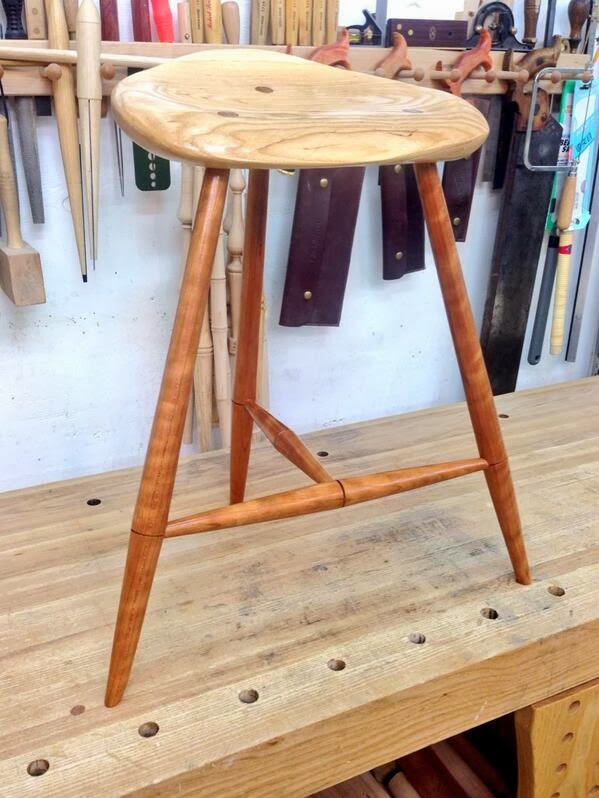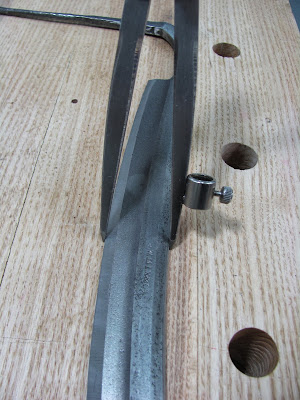At the center of my design is a seat that tilts 10 degrees forward to promote a more ergonomical sitting posture. The three legged design provides a solid base no matter how uneven the surface it sits upon. I chose contrasting colors for the stool. The seat is Ash and the legs and stretchers are Cherry.
I started Saturday morning laying out the seat on a piece of 8/4 Ash and then boring the mortises for the legs. This is where great concentration was required. The front legs raked (angle as seen from the side) 19 degrees and splayed (angle seen from the front/rear) 17 degrees as legs normally would. The single back leg is counterintuitive because of its 1 degree rake toward the front of the seat and 0 degree splay. This is what is needed to give the seat its 10 degree forward tilt.
After boring the mortises I moved onto sculpting the seat. This was my second workout for the day. The first was shoveling out the driveway and the pile of snow the plow left behind. There is a reason that Eastern White Pine (EWP) is used almost exclusively in the making of Windsor Chairs. Ash is hard! What was I thinking, there is a reason they make baseball bats out of Ash.
To change things up I moved onto turning the legs and stretchers. All was going well until the last leg. It was then that a hidden knot revealed itself. My fix was to fill the cavity with epoxy and continue turning. The leg came apart on the lathe. This meant a design change was in order. The only way to save the project was to shorten the legs resulting in a stool that is now 21 1/2" tall.
At this point it was late and I was hungry and a bit dejected at this unwelcome development. So I called it a night deciding to start fresh in the morning.
Sunday morning started with me referring back to my trigonometry tables. I had to determine the correct leg lengths to maintain my required 10 degree forward tilt of the seat. After I had determined the correct length of the legs I moved onto reaming the mortises to a 6 degree taper. In my opinion this is one of the most critical steps in the process. To have the undercarriage symmetrical I had to be spot on with my reaming. Here you can see the 1 degree forward rake of the rear leg.
In the picture below it appears there is one leg when in fact there are two. This indicates that the extra time and care taken during reaming has paid off.
Next was to measure, turn and fit the stretchers. After that was the somewhat nerve racking glue up. First step is to glue up the undercarriage. If everything was done with care and great attention paid to the details the seat should slide on without much effort.
All that was needed was the usual slight pull on the tapered tenon leg tops and into the mortises they slid. Next was installing the wedges perpendicular to the grain of the seat.
After a couple of hours the glue had dried and the tenons and wedges were trimmed flush to the seat. I then scrapped and sanded the seat. All that was left was to apply the finish. First was a seal coat of dewaxed shellac. This was followed by two coats of an oil/varnish mix. After it had dried I rubbed it out with a gray nylon pad and applied one coat of General Finishes Polycrylic to give it the tough protection it will need.
I have to tell you this was a roller coaster of a ride. But once the stool was completed and sitting there it became evident that it was one heck of a good time. Like a roller coaster, I will quickly get in line to participate in another Build Off. Many thanks to Chris Wong of Flair Woodworks for putting on the SSBO. I hope I will see you at the next one, whatever it may be.
~ Ray Schwanenberger
















































